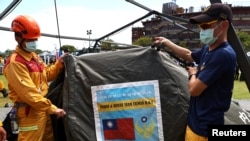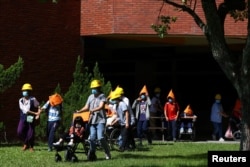Taiwan on Wednesday marked 23 years since the deadly Chi-Chi or “Jiji” earthquake unleashed a wave of destruction that killed more than 2,400 people and upended the way the East Asian democracy approaches disaster management and prevention.
Measuring in at a magnitude of 7.3, the earthquake hit central Taiwan’s Chi-Chi Township around 2 a.m. local time on September 21, 1999, unleashing a wave of force that toppled buildings as far away as Taipei some 145 kilometers to the north.
More than 8,500 buildings were destroyed, with another 6,200 seriously damaged, according to an assessment report by the private sector firm Risk Management Solutions (RMS).
Earthquakes are nothing new to Taiwan, which sits in a zone of quake and volcanic activity known as the Pacific Ring of Fire, but the 1999 Chi-Chi earthquake was particularly deadly due to a number of human-made errors.
The post-earthquake analysis found that many buildings collapsed due to structural problems such as poorly designed load-bearing lower levels, said Lin Thung-hong, a sociologist at Academia Sinica, Taiwan’s top research institution.
Many of these were later attributed to corruption during the island’s building boom of the 1980’s and early 1990’s, as politicians and local leaders turned a blind eye to potential construction and engineering flaws in new apartment buildings.
The anger at the findings would upset the island’s “political landscape,” Lin told VOA, as Taiwan residents demanded more accountability and oversight in the housing and construction industries.
The Chi-Chi earthquake hit just three years into Taiwan’s transition from a one-party state headed by the Chinese Nationalist Party (KMT) to a full-fledged democracy whose leaders were elected by universal suffrage.
In the early days of Taiwan’s transition, the KMT was still largely in control of the government, but the earthquake would help hand the opposition Democratic Progressive Party its first-ever presidential victory six months later as many in Taiwan found the old guard lacking.
“The KMT government at that time did not really perform very well in the early period after the earthquake and it was criticized seriously by local people,” Lin said by phone. “In Nantou and Taichung [in central Taiwan], voters punished the KMT government. The March 2000 presidential election was the first time the DPP government came to power.”
The months after the Chi-Chi earthquake also saw major legislative reform in how Taiwan’s government would handle natural disasters from earthquakes to typhoons, said Elaine Lin Kuan-hai, an assistant professor at National Taiwan Normal University’s Graduate Institute of Environmental Education.
Some regulations were in place, but they would become much more extensive following the disaster. “It’s clear that before the Chi-Chi earthquake in Taiwan, we actually didn’t have a concrete disaster reduction plan or any concrete policy,” she said.
After the quake, officials replaced a basic “action plan” with more detailed regulations about how natural disasters would be handled going forward, from the national level down to village jurisdiction. Communities also began to take more ownership of their local preparation, Lin said, to ensure that they could meet challenges from earthquakes to typhoons.
Major changes were also incorporated into construction regulations, said Chesley Williams, senior director of product management in the Global Earthquake division at RMS, an analytics company. “Taiwan has incorporated seismic design codes since the 1980s, but following the Chi-Chi earthquakes in September 1999, there was a substantial improvement in seismic performance due to new seismic design requirements,” Williams said by email.
Many of these changes include adding dampeners to withstand shocks and changing how buildings are designed, said Tony Yang, an expert in structural and earthquake engineering at the University of British Columbia.
“We cannot make everything earthquake-proof, but we can make it more resilient and more capable of withstanding earthquake shaking,” he said. The most dramatic example of this may be the iconic "Taipei 101” skyscraper, which is topped by a 660-metric-ton pendulum to help it withstand earthquake shocks.
These days Taiwan’s government can also use the island’s extensive cell phone network to send earthquake alerts, which can offer a brief buffer time to prepare for the impact.
While the new wave of reform dramatically changed Taiwan, laws and regulations have not been able to fix everything.
The island sits astride the Eurasian and Philippine Sea tectonic plates, which means earthquakes are inevitable. Scientists have been able to map many of Taiwan’s fault lines and monitor for seismic activity, but tremors are still unpredictable.
Another problem is that even as construction standards were put in place for new buildings, thousands of privately-owned older buildings have yet to be retrofitted, said Academia Sinica’s Lin. Even with government subsidies, some owners find the cost too expensive, he said, which means they might not find out about design flaws until it’s too late.
Such challenges were laid bare in a 2016 earthquake that toppled a 17-story residential building – killing more than 100 people -- and most recently when two consecutive earthquakes hit the southeast coast on Saturday and Sunday, followed by dozens of aftershocks into Monday.
The earthquake activity was felt across Taiwan, killing one person and injuring 165. The shocks derailed a passenger train, buckled roads, damaged buildings and bridges, and toppled a 7-Eleven, while it also left hundreds of hikers stranded on an east coast mountain following a landslide.
UBC’s Yang said there is only so much that can be done but with each earthquake, small improvements can be made as more data is acquired.
“Chi-Chi was not the first earthquake seen by the world. Every time a major earthquake hits, we can learn more information and start adding it to a new [building] code,” he said.








